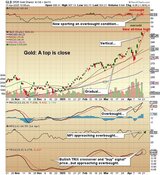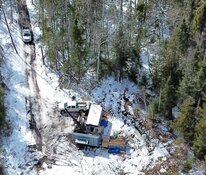The Gold Report: You recently observed that there's $9 trillion of gold stashed away worldwide. Does this mean that short-term gold traders are setting the market price for gold?
Lawrence Roulston: Most of the gold in the world is held for the long term. Only a small portion of total gold holdings is actively traded. Short-term price fluctuations are largely the result of traders reacting to news. A long-term chart of the gold price tells the real story. Gold is trending higher and there are short-term fluctuations, but the long-term direction is obvious.
The important message is that the long-term outlook for gold remains extremely bullish. The gold producers have an ongoing need to replace reserves, and they want to grow their businesses. That's the basis for viewing the exploration and development companies. You're going to beat yourself up trying to figure out what the next short-term move is going to be in the gold price, but if you take this long-term uptrend seriously and look at the companies developing deposits that are likely to be taken over by the larger companies, that's a much better way to play the gold market.
TGR: In February, you told The Gold Report that for gold shares, "the worst is over." Do you still feel that way? Are there signs that a bottom for equities has been reached?
LR: That call was premature. There was a brief rally. It turned around when the gold price dropped. The U.S. dollar replaced gold as a safe haven as people fled from the uncertainty in Europe. At that time, I differentiated between the resource markets overall and the higher-quality junior companies. The message still applies. Better-quality companies with good assets, cash on hand and strong management are building strong bases in their share prices at this time. Some of these companies have come down to the bottom and are trading at cash value. There is not a lot of downside once they're trading at cash value.
We are in the midst of the summer doldrums. People aren't really paying attention to the junior markets. That's going to change in September when people come back from holidays. Investors are going to recognize that companies with good assets are trading for cash value or near that level, and that there is more upside potential than there is downside risk.
"The long-term outlook for gold remains extremely bullish."
The big factor that is really going to drive the markets is takeovers. We're seeing it now. For instance, Avion Gold Corp. (AVR:TSX; AVGCF:OTCQX) just received a takeover offer that was a 70% premium to its 20-day trading price. There are going to be a lot more offers like that, and that's going to make savvy investors pay attention.
TGR: In terms of companies trading at or near their current cash value, are there any firms that you think are a good deal for investors right now?
LR: Keegan Resources Inc. (KGN:TSX; KGN:NYSE.A) has $200 million (M) in the bank, and its market value is not a lot more than that. It has a 5 million ounce (Moz) good quality gold deposit in Ghana. That's an example of how irrational the valuations are in this market now.
TGR: Speaking of rationality, what specific political and economic trends are affecting the price of bullion and the price of gold equities?
LR: Short-term prices are impacted by news headlines, but headlines are not all that accurate. We hear constantly about the slowdown in China. In reality, China is the largest consumer of metal and its economy is growing at better than 7% a year. That's less than the 8–9% growth of recent periods, but it's still a phenomenal pace of growth for the second largest economy in the world.
TGR: What about the so-called euro dilemma?
LR: The situation in Europe is the most significant element impacting investor sentiment. Markets have pretty much discounted a complete collapse of the euro. Personally, I don't think we're going to see a complete collapse of the euro. I think a more practical outlook is that the powers in Europe are moving ever closer toward a wide-open monetary easing in the same way that the Americans used monetary policy to overcome the 2008 global financial crisis. And it worked very effectively in the U.S. The American economy is not booming yet, but it has certainly rebounded from a recession to a period of slow growth.
TGR: What would be the effect of quantitative easing in Europe on gold investors?
LR: Over time, it will be very positive for hard assets in general, and especially for gold, but also positive for the whole range of commodities. Monetary easing depresses the value of currencies. It's inflationary. Hard assets like gold and other metals are going to effectively hold their value in real terms as the value of currencies decline. In the long term, the easing could be very bullish for commodities in general.
TGR: Given that now is a good time to bargain hunt for junior mining stocks, what standards should investors use when evaluating whether a particular junior has a solid chance at making it through the next year or so and emerging as a contender?
LR: The biggest payoff for a junior exploration company comes with a new discovery. We saw that recently with GoldQuest Mining Corp. (GQC:TSX.V). In a period of three months, its stock price went from $0.05/share to $1.50/share. But, unfortunately, discoveries like that are not very common. Investors must balance risk and potential reward by buying companies that have a solid asset combined with a realistic prospect of a takeover. The value of a quality asset increases as the owner expands and upgrades the resource by conducting engineering studies and moving toward production. Companies with solid mining assets and good management teams that are advancing toward production provide the best balance.
"Better-quality companies with good assets, with cash on hand and with strong management are building strong bases in their share prices at this time."
It's hard for companies to raise money. Financings can be dilutive to the point where a company may never recover. But enterprises with cash in hand are in strong positions. And companies with good assets and strong management can still raise money. Pretium Resources Inc. (PVG:TSX; PVG:NYSE), for instance, is presently raising $18M in a flow-through financing that's priced at a 25% premium to market. To be a winner, a project has to have size and it has to have grade. It has to be well located with regard to infrastructure and jurisdiction. Now, having said that, the number of good jurisdictions is shrinking. The most recent downgrade came as Bolivia announced the takeover of a project from South American Silver Corp. (SAC:TSX; SOHAF:OTCBB). It's getting harder and harder to find good-quality assets in favorable jurisdcitions.
TGR: Is that good or bad for the junior investor?
LR: Long term, it's good. The value of the good-quality assets will appreciate. In decades gone by, there was a surplus of good-quality metal deposits available for development. When metal prices rose, a lot of new deposits came onstream and knocked back the metal prices. We saw that cycle repeated several times over the last few decades. But the situation has dramatically changed; there is no longer a surplus of good-quality assets. Finding large, high-grade deposits is getting harder. That means that when a company makes a discovery, the discovery is more likely to yield a high value for shareholders.
TGR: Looking at the relative share prices of junior companies over a two-year window, we see some that are still holding value, despite some downturn in share price. For example, Newstrike Capital Inc. (NES:TSX.V) was $0.40/share in August 2010 and now it's $1.80/share despite having risen as high as $3.40/share in the interim. There are other firms with similar stories. Do you consider this type of comparison to be an indicator of company strength for the long term?
LR: Yes, those price ranges are good indicators of value in this market. There are several ways to explain undervaluation of high quality firms. Some individual investors are terrified and are selling across the board; they want out of all equities. Another huge component in the selling is investment funds, hedge funds and other institutional-type investors who came into the resource sector not really knowing what they were doing. Now they are looking to get whatever they can get for their positions. Consequently, sophisticated investors are picking up great bargains. That companies like Newstrike are still holding value indicates that they have tangible assets and solid management.
TGR: Are there other companies that you are looking at that are holding value comparable to Newstrike?
LR: GoldQuest is up from $0.05/share to $1.80/share in a period of months after a discovery. Where it will go from here, who knows? It will depend on the next drill results.
Pretium is up 2.5 times over the last couple of years.
Extorre Gold Mines Ltd. (XG:TSX; XG:NYSE.A; E1R:FSE) has doubled from two years ago; Sandstorm Gold Ltd. (SSL:TSX.V) has tripled.
These are all companies that have good management and solid assets, which are getting recognition from, in the case of Extorre, another mining company, and for the others, from investors who understand the sector.
TGR: Are some of these juniors with relatively low stock prices benefiting from joint ventures with seniors?
LR: Absolutely. I've always been a fan of the joint venture approach to exploration. It's a very high-risk business, and it's better to use other people's money for the early-stage exploration. For example, Millrock Resources Inc. (MRO:TSX.V) has held up better than some other companies because it benefits from senior companies that are funding the work on its projects. Another example of that synergy is Riverside Resources Inc. (RRI:TSX), which has held up well in a really tough market.
TGR: Can you be a little more specific about Riverside and what's going on there?
LR: Riverside is a prospect generator-type company that has initiated many exploration projects. A number of juniors and seniors are funding work on its projects. It's focused on North America, so it's in good political jurisdictions. It has two deals where it has entered into strategic alliances to conduct regional exploration programs, one in Mexico and another in British Columbia. That kind of business model is very effective, especially for a company like Riverside that is able to attract the big companies that can afford aggressive exploration programs.
TGR: You mentioned Millrock. Can you tell us a little bit about what's going on with that firm?
LR: Millrock has quite a number of exploration projects in Alaska and also in Arizona. It has joint ventures with senior companies. Quite a lot of work is going on at the moment. Any of those projects could turn into a major discovery.
TGR: Tell us more about Newstrike. What makes it attractive?
LR: Newstrike is working on a project in Mexico in a very prolific gold belt. It has a big property position and has made a discovery. It is systematically drilling off the discovery and has potential for additional discoveries on its property.
TGR: I wonder about Africa, which has a host of political and infrastructure obstacles. Are there any undervalued juniors operating in eastern Africa that have drawn your attention?
LR: I like Sunridge Gold Corp. (SGC:TSX.V) a lot. It has a very good project at the feasibility stage. It is gold and base metals. In this kind of a market, investors don't want anything to do with a country like Eritrea, but Nevsun Resources Ltd. (NSU:TSX; NSU:NYSE.A) has been very successful in that country, has developed an operating mine and was able to raise debt financing in the international markets. Sunridge is on the same path to mine development. At its current share price, it's way undervalued.
"I like to focus on firms that have a tangible asset in hand."
When you look at countries within Africa that have various levels of political risk, it comes down to a tradeoff between risk and potential reward. There are some places in Africa that I wouldn't touch under any circumstances, but there are other places that are quite attractive in terms of their level of geopolitical risk, are extremely prospective geologically and, therefore, provide an excellent balance of risk and potential reward. Sunridge is one example.
TGR: What other regions would fit those criteria?
LR: West Africa in general is very positive. Ghana is a good place to be. Ghana and many other countries over the past couple of years have bumped up its rates of taxation and royalties on the mining industry in response to high metal prices. That's turned off a lot of investors, not so much about the level that the royalties and taxes are at this time, but the political situation creates uncertainty as to what it is going to do next. We saw the same thing in Mongolia, which bumped up taxes, said it was satisfied with that, then came back a year or two later and said, "no, we want more." That's really the biggest problem right now, the uncertainty of what's coming next.
TGR: For the retail investor, what are some of the major metrics that an investor could look at to tell the difference between a good-quality company and one that's maybe not so good in today's market?
LR: You have to realize that most of the junior exploration companies have the best intentions in the world of making a discovery next week or next month. They're good geologists, they're well intentioned, but if they're not successful at making a new discovery, they're not going to deliver a lot of value to shareholders. Some of them will make discoveries, and they will provide enormous payoffs for shareholders, as we saw recently in the case of GoldQuest. But, unless they make a discovery, there may not be a lot of value in the vast majority of the companies in this sector.
I like to focus on firms that have a tangible asset in hand. They have made a discovery or they've reinvigorated a discovery that was made at some point in the past. So they have something tangible, and they're adding value to it. It's important to realize that the mining industry has changed dramatically over the past couple of decades. There were discoveries made in the 1980s, 1990s and even the early part of the 2000s that didn't make economic sense at that time. The grade was too low or it was too remote. And of course the metal prices at that time were very much lower than they are today. With higher metal prices and with changing metrics in a number of areas, discoveries from way back are now extremely valuable and, in fact, are some of the best deposits available to the mining industry.
TGR: Before we conclude, are there any juniors that you would like to recommend to our readers?
LR: Companies that are working toward adding value on existing deposits include Kaminak Gold Corp. (KAM:TSX.V), which is drilling a deposit in the Yukon. It will be putting together its first resource estimate later this year. People are going to be very pleased when they see the size of it.
Paget Minerals Corp. (PGS:TSX.V) and its joint partner are working on a very substantial situation in British Columbia. It is a discovery from decades ago that was put aside. Paget reactivated it.
Pretium has outlined 17 Moz high-grade gold ounces on its Brucejack property in British Columbia. The world had seen Brucejack as being a large but low-grade deposit, and the company was able to go in and identify a very substantial, high-grade portion in that deposit.
New Gold Inc. (NGD:TSX; NGD:NYSE.A) is conducting probably the biggest exploration program in the world at the moment on its Blackwater project in British Columbia. That opens up a whole region where there are a number of juniors looking at other deposits or other prospects that might look like Blackwater.
TGR: That sounds promising.
LR: British Columbia is really coming back into the forefront. Not a lot of investors have appreciated the significance of what's happening in British Columbia.
TGR: Well, it has infrastructure. It is politically stable. There are a fair amount of new discoveries going on.
LR: It's one of the most highly prospective geologic areas. It has had a lot of work done in the past, and there are many companies that are now building on that historic work. In fact, I'm working now on a special issue of a newsletter devoted to British Columbia.
TGR: In terms of new extraction techniques?
LR: In terms of companies that are building on work that was conducted in the province in the past, such as Paget, which is drilling on a deposit that was discovered initially in the 1960s. Until recently, it was perceived as having no value, but this might end up being one of the most significant porphyry copper-gold prospects anywhere. There are a lot of situations like this in British Columbia. The province was explored pretty thoroughly in the 1970s and 1980s but at that time, the grades that the enterprises were coming up with weren't high enough to be economic in the context of metal prices. But now the gold price in the last decade is six times higher and the copper price is six times higher. Situations that had little value a decade ago are now highly prospective.
TGR: Do you have any parting words?
LR: A lot of people recognize the long-term fundamentals in gold and the mining industry in general, but they are terrified about the situation in Europe and they're standing back. They're waiting for a signal that the markets are at the bottom. Nobody is going to ring a bell to announce that the market is at the bottom. We saw in the early part of 2009 how quickly the markets could rebound. Within a couple of weeks, the Toronto Stock Exchange Venture Index was up 50% and went on to triple over the next two years.
TGR: We could be in a similar situation.
LR: I believe we are. The really important point is that the high-quality companies are already seeing strong bases building in their share prices and many of them, in fact, are beginning to trend upward. If people wait until there's a signal that the markets are on the way up, it's going to be too late to get a position in the good-quality companies.
TGR: Thank you very much for your time. It's been a pleasure talking to you.
Lawrence Roulston, editor of Resource Opportunities, is a geologist with engineering and business training and more than 25 years of hands-on experience in the resource industry. After completing his studies at the University of British Columbia in 1975, Roulston worked as an analyst for Cominco Ltd. and for a mid-size Calgary oil group for several years. In 1984 he became the CFO for a group of mineral exploration companies. He was also vice president in an investment management firm focused on the resource industry. From 1994 to 1997, Roulston was CEO and director of a mineral exploration company. Since then, he has been a resource industry consultant and independent mining analyst. Roulston's years of hands-on experience and extensive personal contacts in the industry provide unique insights that have generated an impressive track record for Resource Opportunities.
Want to read more exclusive Gold Report interviews like this? Sign up for our free e-newsletter, and you'll learn when new articles have been published. To see a list of recent interviews with industry analysts and commentators, visit our Exclusive Interviews page.
DISCLOSURE:
1) Peter Byrne of The Gold Report conducted this interview. He personally and/or his family own shares of the following companies mentioned in this interview: None.
2) The following companies mentioned in the interview are sponsors of The Gold Report: Pretium Resources Inc., Newstrike Capital Inc., Extorre Gold Mines Ltd., Millrock Resources Inc., Sunridge Gold Corp. and Paget Mineral Corp. Streetwide Reports does not accept stock in exchange for services. Interviews are edited for clarity.
3) Lawrence Roulston: I personally and/or my family and/or Resource Opportunities may own shares of the following companies mentioned in this interview: Keegan Resources Inc., Pretium Resources Inc., Newstrike Capital Inc., Millrock Resources Inc., Riverside Resources Inc., Sunridge Gold Corp., Kaminak Gold Corp. I personally and/or my family am paid by the following companies mentioned in this interview: None. I was not paid by Streetwise Reports for participating in this interview.








































